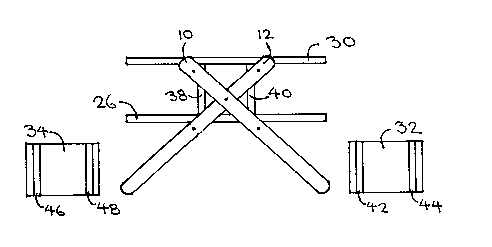Some of the information on this Web page has been provided by external sources. The Government of Canada is not responsible for the accuracy, reliability or currency of the information supplied by external sources. Users wishing to rely upon this information should consult directly with the source of the information. Content provided by external sources is not subject to official languages, privacy and accessibility requirements.
Any discrepancies in the text and image of the Claims and Abstract are due to differing posting times. Text of the Claims and Abstract are posted:
| (12) Patent Application: | (11) CA 2047100 |
|---|---|
| (54) English Title: | CANTILEVERED TABLE - SEATING UNIT |
| (54) French Title: | ENSEMBLE TABLE ET SIEGES |
| Status: | Deemed Abandoned and Beyond the Period of Reinstatement - Pending Response to Notice of Disregarded Communication |
| (51) International Patent Classification (IPC): |
|
|---|---|
| (72) Inventors : |
|
| (73) Owners : |
|
| (71) Applicants : |
|
| (74) Agent: | |
| (74) Associate agent: | |
| (45) Issued: | |
| (22) Filed Date: | 1991-07-15 |
| (41) Open to Public Inspection: | 1993-01-16 |
| Availability of licence: | N/A |
| Dedicated to the Public: | N/A |
| (25) Language of filing: | English |
| Patent Cooperation Treaty (PCT): | No |
|---|
| (30) Application Priority Data: | None |
|---|
ABSTRACT OF THE DISCLOSURE
A cantilevered table - seating unit comprising a table
top, four easy to access seating positions for adults and/or
older children and two enclosed seating positions for younger
children. The two enclosed seating positions have removable
covers which serve to increase the area of the table top when
one or both of the enclosed seating positions are not being
used, provide arm rests for each of the four seating positions
for adults and/or older children, and function as booster seats
to raise the height of the enclosed seating positions in
relation to the table top. Four legs, combined into a couple
of cross braces, serve to support the table top and seating
areas in a way that provides easy access to the four adult
and/or older child seating positions, provide a wide base for
the unit to prevent tipping when the unit is unevenly loaded,
and prevent sway along the length of the unit.
( 2 )
Note: Claims are shown in the official language in which they were submitted.
Note: Descriptions are shown in the official language in which they were submitted.

2024-08-01:As part of the Next Generation Patents (NGP) transition, the Canadian Patents Database (CPD) now contains a more detailed Event History, which replicates the Event Log of our new back-office solution.
Please note that "Inactive:" events refers to events no longer in use in our new back-office solution.
For a clearer understanding of the status of the application/patent presented on this page, the site Disclaimer , as well as the definitions for Patent , Event History , Maintenance Fee and Payment History should be consulted.
| Description | Date |
|---|---|
| Inactive: Inventor deleted | 2002-05-06 |
| Time Limit for Reversal Expired | 1995-01-17 |
| Application Not Reinstated by Deadline | 1995-01-17 |
| Deemed Abandoned - Failure to Respond to Maintenance Fee Notice | 1994-07-15 |
| Inactive: Adhoc Request Documented | 1994-07-15 |
| Application Published (Open to Public Inspection) | 1993-01-16 |
| Abandonment Date | Reason | Reinstatement Date |
|---|---|---|
| 1994-07-15 |
Note: Records showing the ownership history in alphabetical order.
| Current Owners on Record |
|---|
| DAVID WANKE |
| Past Owners on Record |
|---|
| None |